Dream Machine 2014

How we built a $30,000 PC
There’s really nothing wrong with excess. Who would complain, after all, of having an excess of money, an excess of vacation, or an excess of hugs? We say the same for this year’s Dream Machine, which makes absolutely no apologies for having an excessive amount of hardware. An excessive amount of power.
When we sat down to sketch out this year’s Dream Machine, we decided that rather than the normal King Solomon decisions between this CPU or that CPU, this GPU or that GPU, it would be easier (and more entertaining) to just have it all.
Yes, we’d have our own cake, and we’d eat the damned thing, too. We’d actually take it with us and yes, we’d actually get what we want. Thus, we built a Dream Machine that has the best GPUs available from AMD and Nvidia. We have both Haswell and Ivy Bridge-E. So, sit down and prepare to feast you eyes on the most excessive Dream Machine in our magazine’s entire history: The Supreme Ruler of All Dream Machines.
Inside Dream Machine 2014
Unlike some platforms where looks are the only thing that matters, PC users also care about what’s inside. See, we are the more sensitive ones, after all. What’s inside this year’s Dream Machine is an eye-popping display of the best hardware available today. Come have a look inside.
The Price List
| Intel Core i7-4790K CPU | www.intel.com | $340 |
| Intel Core i7-4960X CPU | www.intel.com | $1,050 |
| 96GB Corsair Dominator Platinum RAM | www.corsair.com | $1,738 |
| 2x Radeon R9 295X2 GPUs | www.amd.com | $3,000 |
| 2x EVGA GeForce GTX Titan Z Hydro Copper GPUs | www.evga.com | $6,700 |
| Asus Rampage IV Extreme BE | www.asus.com | $500 |
| Gigabyte GA-Z97X-Gaming G1 | www.gigabyte.com | $379 |
| 4x Hitachi He6 HDDs | www.hitachi.us | $2,400 |
| 4x Samsung EVO 1TB SSDs | www.samsung.com | $1,800 |
| 2x LG WH16NS40 ODDs | www.lg.com | $135 |
| 2x Windows 8.1 Professional Retail | www.microsoft.com | $348 |
| Red Harbinger Cross Desk | www.frozencpu.com | $2,000 |
| Corsair AX1500i X2 PSU | www.corsair.com | $622 |
| EVGA SuperNova 1600 G2 PSU | www.evga.com | $350 |
| Yamaha RX-V477 Receiver | www.yamaha.com | $450 |
| Yamaha NS-PA40 | www.yamaha.com | $400 |
| 2x Asus PB321Q Ultra HD Monitors | www.asus.com | $4,805 |
| Corsair Vengeance K95 RGB | www.corsair.com | $190 |
| Razer Ouroboros | www.razerzone.com | $150 |
| Qnap TurboNAS TS-470 | www.qnap.com | $1,000 |
| Custom Cooling and Parts | www.frozencpu.com | $1,650 |
| $30,007 |
Intel Core i7-4790K
It’s hard to believe, but after decades of making CPUs, Intel has finally broken the 4GHz barrier with its Devil’s Canyon—which isn’t really all that new, of course. It’s essentially an Intel Core i7-4770K but made to overclock like a mother. To do that, Intel beefed up the CPU’s power delivery with additional capacitors and used a “next-generation polythermal interface material” that’s supposed to be far better than current thermal paste or goo in 4770K parts. This, loyal readers, adds up to a chip that starts at 4GHz and has a turbo boost of 4.4GHz.
PC Gamer Newsletter
Sign up to get the best content of the week, and great gaming deals, as picked by the editors.
Other than that, it’s still the same Haswell microarchitecture we’ve come to love. The 22nm question, though, is how far could we overclock this chip that was built explicitly for overclocking? A duplicate part in this month’s Build It section hit 4.7GHz on a CLC. We’re expecting more—but not much more—as few have taken Devil’s Canyon’s parts above the best Haswell chips. In many ways, the best way to think of Devil’s Canyon is that every chip is “good,” while it was a crap-shoot with the original Core i7-4770K parts.
Intel Core i7-4960X
In CPU technology, the Core i7-4960X has some gray hair, but it has a couple of big advantages over its Haswell sibling. The first is core count. Ivy Bridge-E offers up to 12 threads with six physical cores over the quad-limited Haswell part. Sure, Haswell may be more efficient clock-for-clock, but when the workload requires more CPU threads, Ivy Bridge-E is king. The other big advantage Ivy Bridge-E has over Haswell is in PCIe lanes. Even on the newest Z97 boards, you get 16 PCIe Gen 3.0 lanes to share among the GPUs with another eight weak-sauce PCIe Gen 2.0 lanes from the Z97 chipset. Ivy Bridge-E gives you a fat 40 lanes of PCIe Gen 3.0 plus another 8 PCIe Gen 2.0 in the X79 chipset.
So, despite its age, Ivy Bridge-E is the current king of CPUs for those who need the core and thread count. Yes, it would have been nice to, say, have a Haswell-E and X99 chipset occupying this slot, but at this point, it would have been like wishing we had a Dream Machine built with Skylake and Skylake-E. But let’s not get into too much coulda-woulda or sibling rivalries. Both chips here are fighting on the same team this time.
Gigabyte GA-Z97X-Gaming G1 WIFI-BK
Anyone who has built enough rigs has had a DOA board. That’s what Gigabyte should all but eliminate with its new Black Edition series. While most motherboards are batch tested or fired up briefly to prevent shipping DOA boards, few are put through any real testing. With Black Edition boards, Gigabyte takes every single motherboard, installs it in a rack with CPU and RAM, and stress-tests it for one week straight before sending it on its merry way.
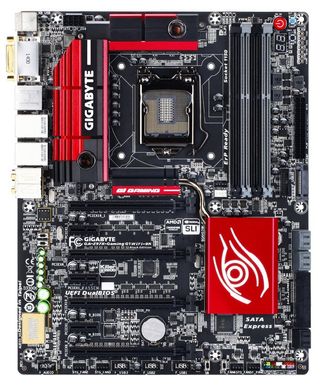
The GA-Z97X-Gaming G1 WIFI-BK is also dream-worthy in that it supports just about every item on the check list of things you need or want from an LGA1150 mobo. With its PLX chip, you could run four GPUs from Nvidia or AMD. If you can’t decide between a Killer NIC or Intel NIC, no worries, it has both. The audio path is separated on the board to reduce interference, and it even has Creative’s SoundCore and a TI Burr Brown OPA2134 op amp. The only thing not to like is the price, but this is Dream Machine and when has that ever stopped us?
Asus Rampage IV Black Edition
That other board may have a 168-hour “server-grade” burn-in test and sport the Black Edition moniker, but Asus knows that when you call something Black Edition, you actually make it all black. The Rampage IV BE is, of course, based on LGA2011, which has been kicking butt and texting names for years now. The board is decked out with all the bling you’d want today, from four-way GPU support to a separated audio path, CirrusLogic DACs, headphone amp, and that awesome sonic radar (cheater) mode. More importantly, combined with our Core i7-4960X, the Rampage IV Black Edition gives us 40 PCIe lanes in Gen 3.0 mode. While you can run two Radeon 295X2 cards in a Z97 board, it’s not actually recommended by AMD. Instead, the company says, if you want big-boy GPUs, you need the big-boy chipset and CPU, too. If you thought our Z97 was pricey, take a knee, because the Rampage IV Black Edition will set you back five hunnert, making it easily one of the most expensive non-workstation-grade motherboards around. That’s a good thing, because this year’s Dream Machine demands nothing less.
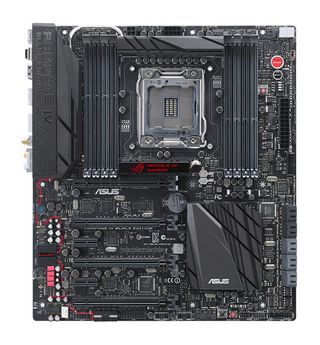
AMD Radeon R9 295X4
There’s no doubt that in this round of the dual-GPU wars, AMD has out-maneuvered its competitors wearing green. And few will disagree that the Radeon R9 295X2 is the winner on gaming performance and also price. At $1,500, the Radeon R9 295X2 is half the price of the Titan Z and edges it in a lot of tests.
So when we spec’ed out this year’s rig, we just knew we’d have to have a Radeon R9 295X2 on our Dream Machine Team. But what could make a Radeon R9 295X2 even better? How about a Radeon R9 295 X4? OK, there’s no actual such beast, but if you take two Radeon R9 295X2 cards, that’s actually X4 based on the rules of marketing.

The R9 295X2 itself is basically a pair of Radeon R9 290X cards, but uses an Asetek custom-designed CLC to keep the GPUs from incinerating your PC. The CLC amazingly keeps the GPU cool and quiet without sounding like a Hoover vacuum. How would CLC X2’s do against a pair of Titan Zs with custom cooling? We don’t care. Again, both are on the same Dream Machine Team.
Asus PB321Q
Was the CPU the hardest choice this year, or the GPU? Perhaps the PSU or keyboard? Nope. The monitor choice was the most hotly contested item in this year’s Dream Machine because there were simply so many directions to go. Surround 4K? Surround G-Sync? A Cinerama Dome of monitors, perhaps?

In the end, we decided that our desk space (literally) and the reality of 4K surround today (it’s a pain) meant that we’d tap on an old friend: the Asus PB321Q. The PB321Q graced last year’s Dream Machine and it’s good enough that we’re bringing it back. Of course, one isn’t enough for us this year, so we brought along a friend: a second PB321Q panel. Both 32-inch panels pretty much take all the space available on our Red Harbinger Cross Desk.
This panel is still the king of the 4K panels in terms of readability. It’s just big enough that you can actually use it without squinting. The panel isn’t a basic TN part, either. It uses a Sharp IGZO panel that’s glorious to witness.
EVGA GeForce Titan Z
We know, we know, anyone who uses a Titan Z in a full-sized desktop rig is nuttier than a fruit cake that’s been passed around for four Christmas seasons. To a crew trying to build a Dream Machine designed to shock and awe readers, that’s like waving a red flag—or should we say green flag—of insanity. So, to officially piss off those practically minded folks already typing “Dear Editor” emails, we didn’t use just one, we used two EVGA GeForce GTX Titan Z Hydro Copper cards in Quad SLI. With its factory liquid-cooling jacket, the card features a higher boost clock than the stock Titan Z, and even higher than the Superclocked unit on air. Even better, on liquid, the card is now a dual-slot card GPU, unlike the three-slot air-cooled version, so it’ll fit in more boards.
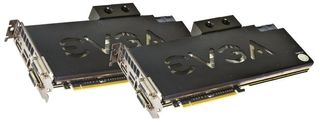
So, which card wins this grudge match? We don’t care. That’s because in Dream Machine 2014, both pair of cards are fighting for us, not against us. Think of it as an issue where the X-Men and Brotherhood of Evil Mutants fight on the same side against the evil of low frame rates and inadequate computing.
Corsair Dominator Platinum
Long ago, we adopted the military mantra of “No slot left behind” for Dream Machine builds. This year we did it again by not leaving a single RAM slot available. For our Ivy Bridge-E box, that means we used 64GB of Corsair Dominator Platinum DDR3/2400 modules. Another 32GB of DDR3/2400 Dominator Platinum modules goes into the Devil’s Canyon box. That gives us a grand total of 96GB of RAM in the Dream Machine. For old time’s sake, we’ll point out that Dream Machine 1996 had 32MB of RAM. We’ll say that again: 32 megabytes of RAM.

To spiff them up, we used a set of Corsair’s brand new classy-looking RAM coolers, too. As Tom said, “these coolers really tied the room together.” Although we’re normally dismissive of dedicated RAM coolers, we actually found our RAM getting to uncomfortable levels on our IVB-E box before we installed the Corsair Dominator Airflow Platinum.
1TB Samsung EVO
SSDs have been a life-changing affair since their modern iterations hit the streets back in ’07 or so. If you’re reading this and you’re not running one, drop this magazine on the bathroom floor and run—don’t walk—to the store to buy one. Since, frankly, SSDs have been performance-gated by the SATA 6Gb/s connection for some time now, we decided to go for capacity with a pair of a pair of 1TB Samsung EVO drives in RAID 0. That gives each machine 2TB of super-wicked-fast SSD, but without the capacity limits that usually have us throwing out ISO and MPEG files well before they deserve to be tossed overboard.
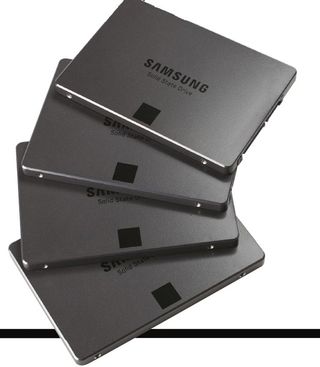
Though it’s not SLC or even MLC NAND, Samsung gets around the performance limits with its TLC by buffering writes to a 36GB SLC NAND buffer. And yes, we know some will fear TLC’s lower life span but honestly, you will not wear out the TLC memory in an SSD anytime before you pull it from your system and laugh the same way you would at an 80GB hard drive. “What, a 1TB SSD? I have a 10TB USB flash drive!”
Hitachi 6TB Ultrastar He6
Few of us would argue that hard drives are dead but we agree that in order to even be useful, they need to keep getting bigger. Well, it doesn’t get any bigger than Hitachi’s Ultrastar He6 HDD. As the name implies, each drive can store 6TB on its seven platters. If you’re floored that Hitachi has stuffed seven platters into one unit when five has usually been the limit, know that the company did this through sealing each drive and filling them with helium, which is used to reduce resistance. Since each drive is sealed, it’s actually possible to dunk the unit into a non-conductive substance, such as mineral oil, for enhanced cooling—if you’re so inclined. Mineral oil wasn’t in the cards this time, but a nice, fat 24TB of storage was. To think that just a few years ago, we stuffed four drives into a machine to get to 2TB is mind boggling. So let the downloading begin in earnest and never, ever erase anything again!
Custom Cooling
How badass is this year’s Dream Machine? The bill for our cooling costs more than most people’s entire builds. Srsly.
With three XSPC AX360 rads, a pair of Swiftech MCP655 pumps, Bitspower quick disconnects, and Bay Reservoirs, Phobya compression fittings, plus two EK Supremacy blocks plus an assortment of lights and doodads, we easily cracked the $1,650 mark just in cooling parts.
As with any plumbing job, it didn’t go as smoothly as we hoped. In rushing to get our PC ready for photography, we plumbed up the Titan Zs incorrectly, which required a 10-minute fix and the reward of hands dyed green for a day.

In hindsight, we’re also not sure we’d make our picks of the rectangular Bay Reservoirs again. We originally made the choice based on shape as we thought they would look just right on the tray of the Cross Desk. Unfortunately, the reservoirs were smaller than we expected. In hindsight, a pair or four of tube reservoirs might have made a better choice. Still, we’re happy with the choices we made. With liquid cooling, it’s more expression of art than plumbing, so there is no real wrong answer.
Yamaha NS-PA40 5.1 Speaker System and RX-V477 Receiver
If you’re going to be sitting at this desk, bathing in the glory of a rig this ambitious, you’re not going to prop up a tiny set of 2.1 speakers and call it a day. No, for something like this, you’re going to want a surround-sound system. When casting our eye about for options, we ended up turning to Yamaha for a set of relatively affordable 5.1 speakers that’d not only rock our ears, but also manage to remain discreet and not distract from the visual sweetness that is Dream Machine 2014.
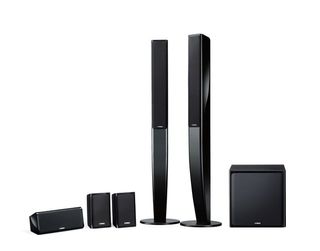
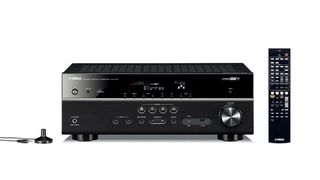
The NS-PA40 fits the bill with its sleek front tower speakers, a compact center, and a subwoofer that fits perfectly under our desk. We definitely recommend following the recommended configuration and putting the towers in front and the satellites in the back (though our photo shows just how neatly they fit on our desktop). Paired with the feature-ladden RX-V477 receiver, we’re able to switch back and forth between systems (as well as music services and auxiliary devices) in a flash.
Most Popular


